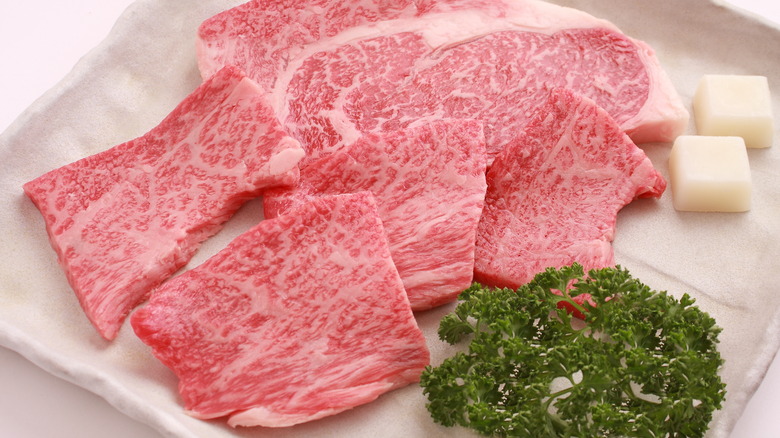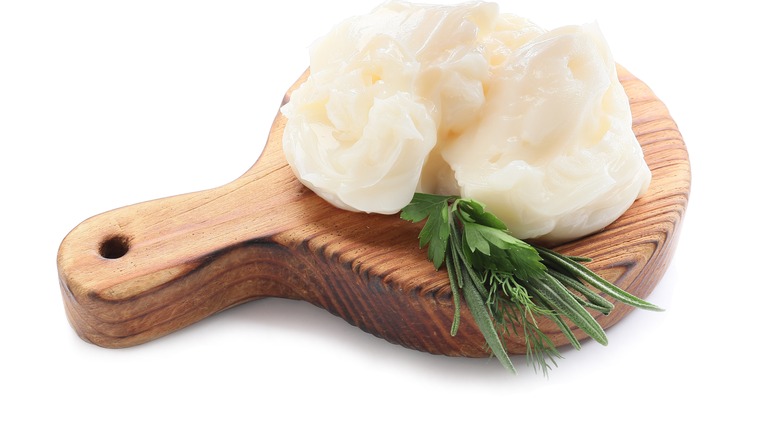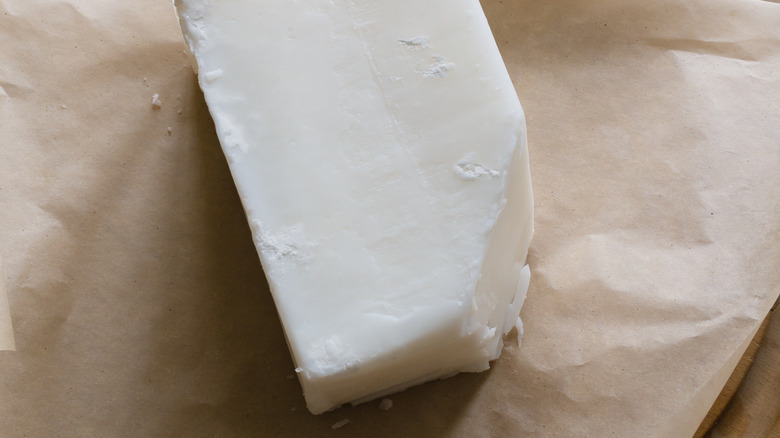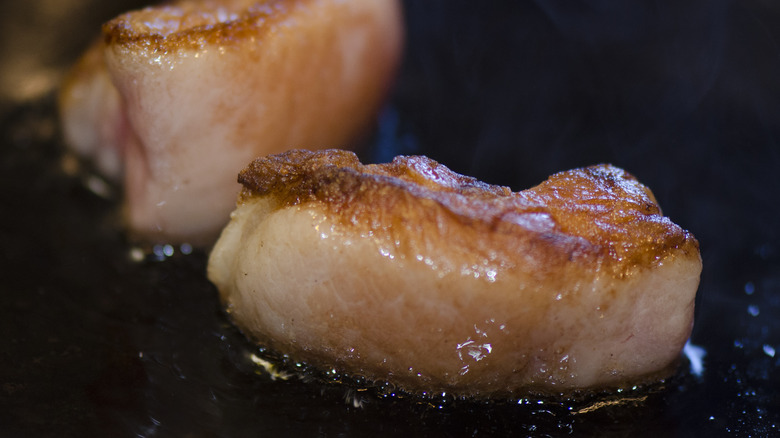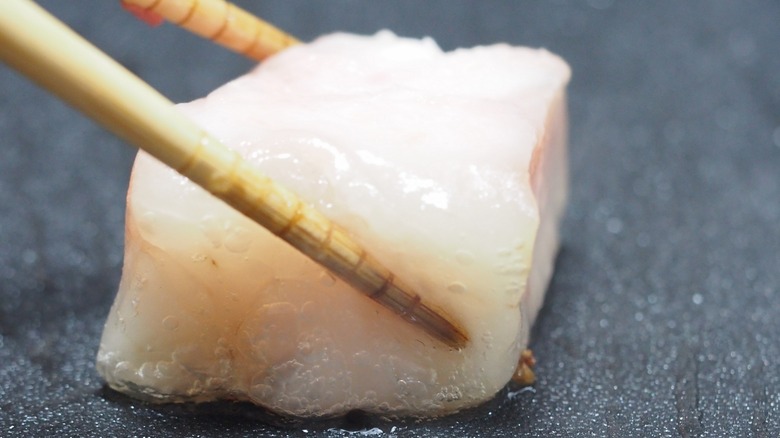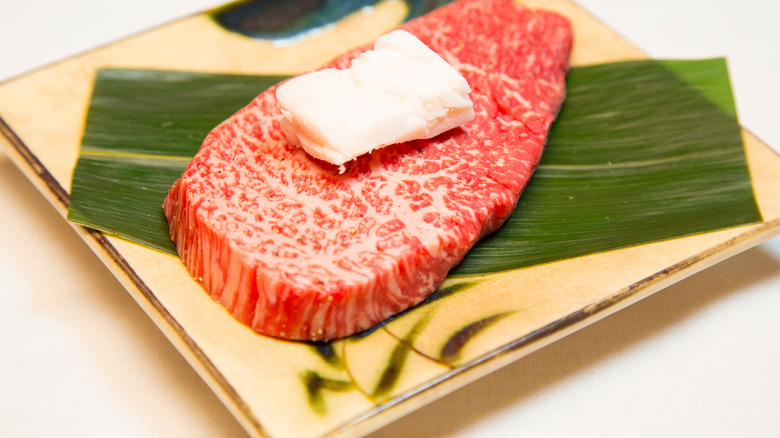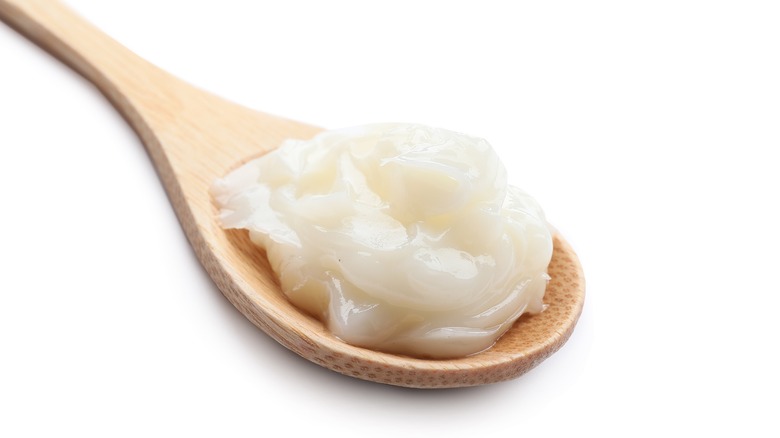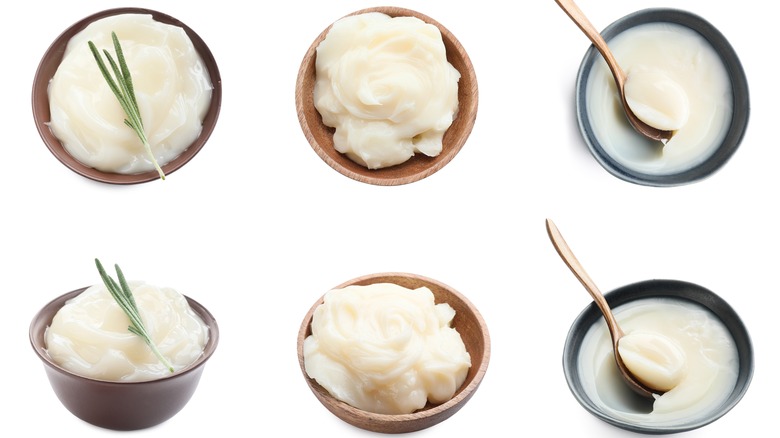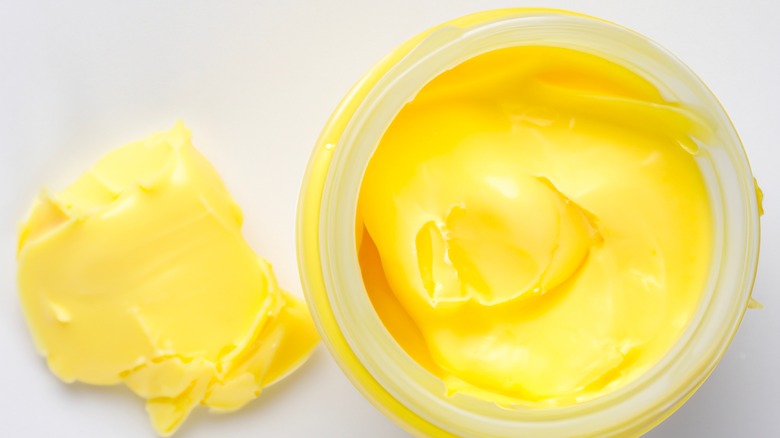What Is Beef Tallow And How Do You Cook With It?
Quick show of hands: How many of you currently have beef tallow in your kitchen? If your first response to that question is, "Why would I want that stuff in my house?" we're not surprised. There's a good chance you've only heard the term used in association with candle making or soap making in old Western novels, and those were (and still are) some of its many uses. But because beef tallow is simply rendered beef fat, it is indeed edible, and was historically used in recipes for sausage and pemmican (a Native American dried meat preparation) as well as a frying medium. With modern concerns about cholesterol and saturated fat, however, beef tallow and other animal fats fell out of favor as cooking ingredients. And this is a shame — while we're not going to pretend beef tallow is diet food, it has a lot of benefits for cooks and eaters.
Fortunately, however, the stigma is starting to lift. With the rise of paleo and high-protein diets and their more generous attitudes toward animal fats, as well as the nose to tail movement and its goal of honoring butchered animals by using every part of them, animal fats such as beef tallow are getting a second look. Not only does it make use of fat and trimmings that would otherwise be discarded, it does so deliciously. Curious? Here's what you need to know about beef tallow.
What is beef tallow?
Beef tallow (rendered beef fat) has been in use for almost as long as humans have been raising cattle. The first records of beef tallow date to the Bronze Age, when it was used to make soap and candles, as well as fuel for torches and lamps. Ancient Romans also used it in much the same way we use lard and butter today, for frying and other cooking needs.
It's worth noting that the definition of "tallow" varies across regions. In the United States, tallow is defined as any rendered animal fat — once this fat has cooled, it hardens to a solid, waxy consistency. In the U.K., on the other hand, such generic rendered animal fat is called "drippings" (because historically, this fat was collected after it dripped from roasting meats). Tallow, to U.K. butchers and cooks, has a narrower definition: It's the rendered fat from around the kidneys, which is said to be softer, richer, and more nutritious than fat from other parts of the animal.
How is beef tallow made?
Beef tallow has been around for a long time because it's so straightforward to make — simply melt down some beef fat and strain it. Today, most commercially available beef tallow is produced by the meat industry, which sends the unsellable remnants of butchered animals to rendering plants to be processed, packed, and sold. But it's also easy — and inexpensive — to make at home. If you regularly trim your own roasts or other beef cuts, save the fat trimmings in the freezer until you have a few pounds of fat. (Alternately, ask your butcher for some trimmings — there's a good chance they'll happily give them away).
To render the fat, put it in a large pot and add a cup of water (assuming you have around 3 or 4 pounds of fat). Simmer over low heat (the water helps prevent the fat from burning), stirring regularly, until the fat has fully rendered — there will still be some solid pieces of fried meat left and the liquid fat will look yellow. Remove any large pieces of meat/fat still left, and pour the liquid fat through a fine-mesh strainer to remove any impurities. A coffee filter, sheet of cheesecloth, or even a paper towel in the strainer will ensure your finished tallow is clear. Pour into clean jars to store; once cooled, the fat will turn white.
Beef tallow vs. suet vs. lard
It's easy to confuse beef tallow, suet, and lard, since most of us don't cook with them much. While all are forms of animal fat, each has its own unique characteristics and uses in cooking, and knowing when and where to deploy each can help you add even more flavor to your dishes.
Beef tallow, for American cooks, is beef fat from any part of the animal that has been rendered (that is, melted down and stripped of any excess water and impurities). While liquid when warm, it solidifies at room temperature. Suet is the fat surrounding the kidneys of an animal. This fat is softer and richer than other fat with a more intense yellow color. It's sold in its solid, un-rendered form (typically shredded into small bits) and is traditionally used in baking to make tender pie crusts and puddings. Lard is the porcine analog to beef tallow — plain, rendered pork fat. It has a distinctly porky flavor, which you should keep in mind if you're considering it as a substitute for beef tallow.
What does beef tallow taste like?
If you remember McDonald's French fries tasting better when you were a kid — or have heard older friends and relatives reminisce about how amazingly rich those fries were back in the day — there's a reason for it, and it's not just nostalgia: Up until 1990, McDonald's routinely cooked its fries in beef tallow, giving them a deep, meaty flavor that complemented their burgers. A deep-pocketed health activist pressured the chain into switching to hydrogenated vegetable oil (whose trans fats later proved to present health risk of their own). And while the fries are still excellent, to many longtime fans, they're simply not the same as they used to be.
While mildly flavored, beef tallow does bring a hearty, savory note to everything it's cooked with. Meat lovers appreciate how it makes beef dishes even beefier, and use it to baste slow-smoked briskets to both keep them moist and augment their flavors. You can even cook steaks in beef tallow for extra richness and moistness. But tallow's flavor also complements other foods — we're looking at you French fries, as old-time McDonald's fans will confirm.
How to cook with beef tallow
Using beef tallow in the kitchen is pretty straightforward — you can use it the same way you'd use any other cooking fat, such as oil or butter. For instance, eggs fried in beef tallow and topped with herbs make a hearty and flavorful breakfast or light supper. You can also incorporate it into baked goods such as pastry crusts, as long as you're aiming for a meaty, savory flavor. So while it can add a welcome extra note of beefiness to the crust of a meat pie, you probably want to stick with butter for your desserts.
A special strength of beef tallow, however, is its high smoke point, which means it can be heated to higher temperatures than many other cooking oils without smoking or burning. With a smoke point of 400 degrees Fahrenheit (the same as canola oil), beef tallow is a useful fat for high-temperature cooking methods such as searing, stir-frying, and deep frying, especially if you want an extra punch of flavor neutral oils can't provide. Just be sure to serve whatever you cook in beef tallow while it's still good and warm – the tallow will harden and become unappetizingly waxy if allowed to cool.
Where to buy beef tallow
While beef tallow is easy and cheap to make at home, there are also plenty of places where you can buy it. It may not be as common or easy to find in average supermarkets as butter or lard, for example, but beef tallow is available if you know where to look. Your best bet would be to check out a butcher shop. While it might be on display with the meat stock and bouillon, it's possible you'll have to ask for it.
If you're looking for beef tallow at your supermarket, the most likely places to find it will be in the cooking oil aisle, the organic or specialty food sections, or at the meat counter. It will come either in jars or in a solid block. Less common is liquid beef tallow, sometimes labeled "beef tallow oil." Farmers markets are another good place to look for beef tallow. But even if you can't find beef tallow locally, all is not lost — numerous online specialty retailers sell it as well.
How nutritious is beef tallow?
Beef tallow and other animal fats have long had a reputation as an artery-clogging menace. But while there's no denying beef tallow is fattening (100 grams contain a whopping 902 calories, according to the USDA), a closer look at its composition reveals it's not the villain it's been made out to be. In recent years, nutritionists have come to take a more nuanced view of dietary fats, distinguishing between those that contribute to cardiovascular and other diseases (trans fats and some types of saturated fat) and those that can actually reduce the risk of disease (such as monosaturated and polyunsaturated fats, as well as saturated fats with long molecules).
Seen through this lens, beef tallow looks a lot healthier than the vegetable-based trans fats in most of our junk food. Half of the fats in intermuscular beef fat is monosaturated or polyunsaturated, and about a third of its saturated fat is stearic acid — a "good" saturated fat type that does not contribute to the production of "bad" cholesterol. In addition, beef tallow is also a good source of vitamins A, D and E, as well as conjugated linoleic acid, known for its anti-inflammatory properties.
Kinds of beef tallow
If you're looking for beef tallow, you'll likely find it in a few basic forms: jarred, in tubs or sealed boxes (for larger quantities) , or sold as solid chunks (the latter is often intended for use in making candles, soap, or cosmetics, rather than for food).
Edible beef tallow can take on several forms as well. An especially luxurious variety is Wagyu beef tallow, made from the ultra rich fat of Wagyu cattle, which boast heavily marbled meat (and because of their relative rarity, command exceptionally high prices). It can be used the same way as regular beef tallow in cooking, but lends an even richer, more distinctive flavor. If you're a grilling and barbecuing aficionado and interested in making your own beef tallow, a fun and flavorful variation to try is smoked tallow. Instead of rendering your fat trimmings on the stovetop, do it in your smoker over low heat. The smoky, flavorful tallow that results will take your burgers (and so much more) to the next level.
Here's the best way to store beef tallow
Another great thing about beef tallow is it doesn't require a lot of pampering. Pure beef tallow, with no impurities such as stray meat particles, is in principle shelf-stable and should maintain its quality at room temperature for up to a year. Any longer, and it may turn rancid. It will stay fresh longer, however, if refrigerated — up to 18 months. And freezing it extends its lifespan even longer, enabling it to maintain its freshness for up to two years. Be aware, though, that frozen tallow is rock hard, so if you use it (or chilled tallow), be sure to budget in enough time for it to return to room temperature.
If you buy tallow and want to be sure it will last, check its expiration date before putting it in your cart: The one-year deadline starts when the tallow was packed, not when you buy it. If you make your own tallow, you should err on the side of caution and store it in the refrigerator or plan to use it fairly quickly — but if you're enthusiastic enough about beef tallow to make your own, you're probably planning on using it soon.

